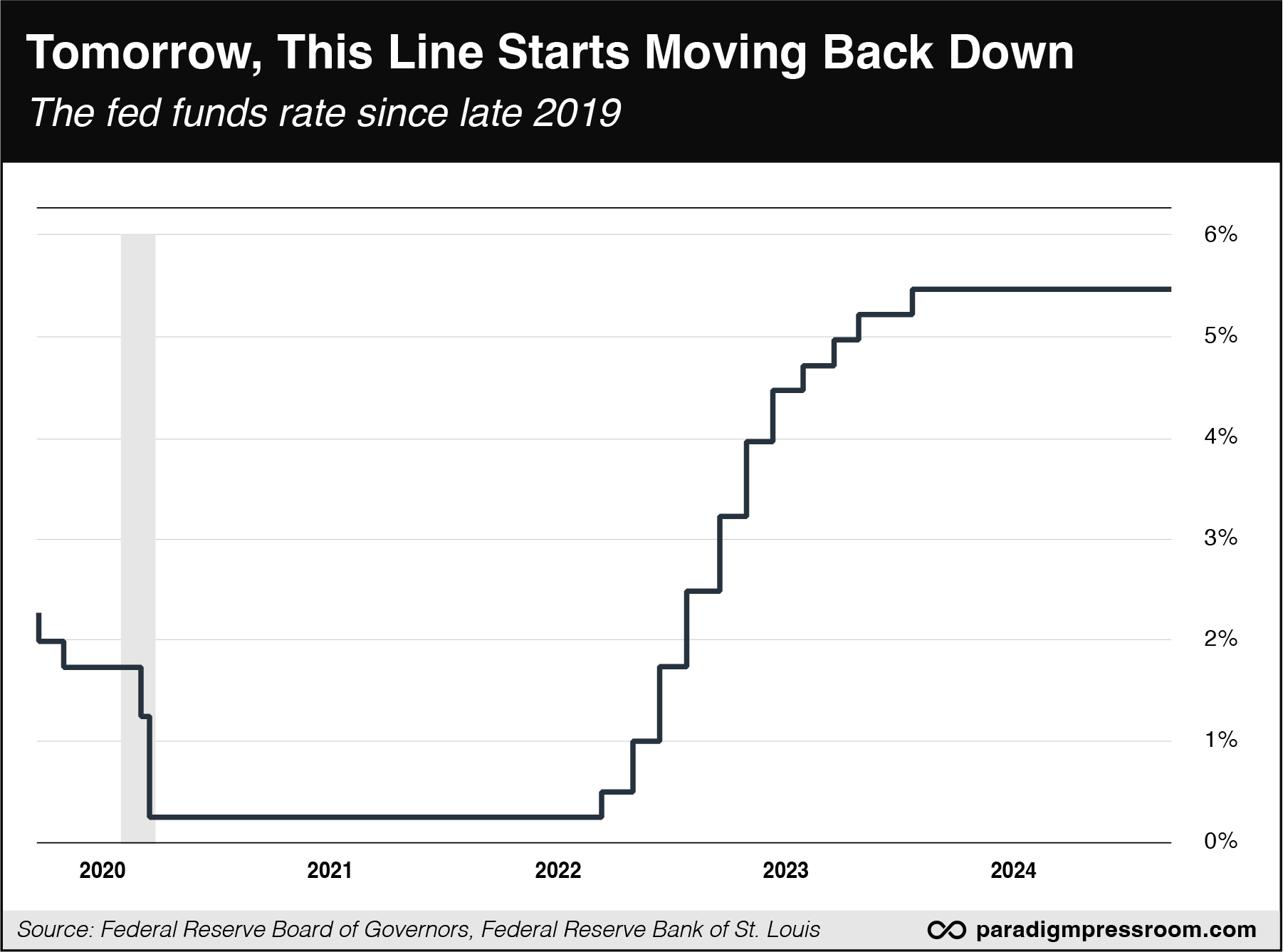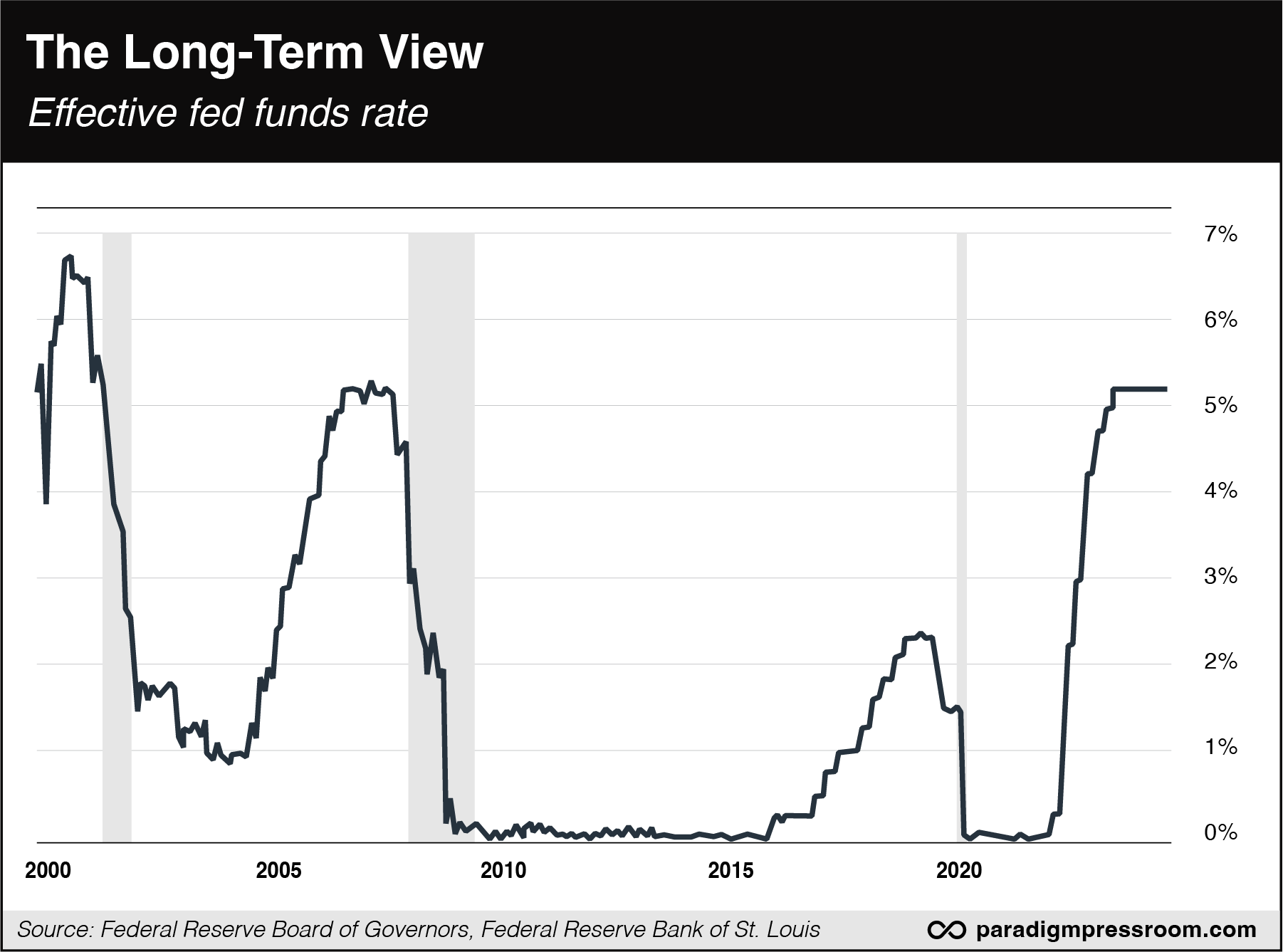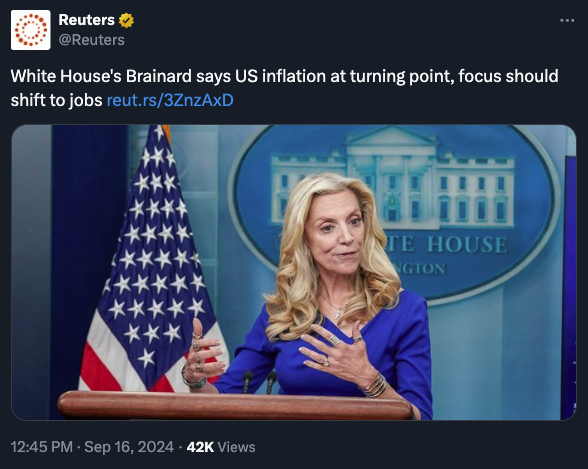Before the Fed Cuts Rates, Do This
![]() For the First Time Since 2000…
For the First Time Since 2000…
 Tomorrow at 2:00 p.m. EDT, the Federal Reserve will do something it hasn’t done in 24 years.
Tomorrow at 2:00 p.m. EDT, the Federal Reserve will do something it hasn’t done in 24 years.
As you probably know by now, the Fed is set to embark on a new cycle of interest rate cuts.
The immediate backdrop: The Fed kept its benchmark fed funds rate pinned near zero in the immediate aftermath of the COVID lockdowns in 2020. Inflation began to take off in 2021. So in March 2022, the Fed launched a cycle of rate increases — the steepest since the early 1980s. From near zero, the fed funds rate was jacked up all the way to 5.5% by July 2023.
That’s where it’s sat for nearly 14 months. Tomorrow, the Fed will start to ratchet it back down.

It’s those increases that drove a host of other interest-rate increases throughout the economy: For instance, an under-3% mortgage in 2021 became an over-7% mortgage for a while last year.
Of course, in the bigger sweep of history, the Fed has engaged in previous cycles of interest rate cuts…
 But this year will be the first time since 2000 that the Fed is cutting rates without a financial crisis going on at the same time.
But this year will be the first time since 2000 that the Fed is cutting rates without a financial crisis going on at the same time.
Let’s zoom out on the chart we showed you above — and go back to the start of this century.

As you can see, there’ve been three previous rate-cutting cycles…
2019–2020: As we mentioned yesterday, there was already turmoil in financial markets during the months before the onset of COVID — a crisis surrounding exotic instruments called “repos.” Rate cuts were part of the early response, although it was only after the COVID panic was in full swing that the fed funds rate was slashed to near zero.
2007–2008: The Fed began cutting rates in September 2007 — a few weeks after Bear Stearns liquidated two hedge funds and BNP Paribas blocked withdrawals from three hedge funds. Those incidents were among the early rumblings of the global financial crisis that went critical a year later when Lehman Bros. went under.
2000–2001: The Fed began cutting rates gradually, and then aggressively, as the dot-com bubble burst.
Yes, the stock market took a nasty spill at the start of this century — the Nasdaq tumbling 78% by late 2002! — but on this earliest occasion the financial system was not at risk of cracking up. Nor is there an imminent risk now, last year’s stresses in the regional banks notwithstanding.
Now… as you might notice from those gray vertical bars, the economy fell into recession amid all three of these rate-cutting cycles. In that sense, the cuts were either ineffective or the Fed acted too late.
It remains to be seen whether the Fed can avert a recession this time: If it can, it would be the first time since the mid-1990s that the Fed has pulled off a “soft landing” after a cycle of interest-rate hikes.
 But for our purposes today… it actually doesn’t matter whether there’s a recession or a financial crisis. Because there’s one sure-fire asset class when the Fed starts cutting rates.
But for our purposes today… it actually doesn’t matter whether there’s a recession or a financial crisis. Because there’s one sure-fire asset class when the Fed starts cutting rates.
If you’ve already had a chance to check out James Altucher’s latest chat with Paradigm’s VP of publishing Doug Hill, you already know what we’re talking about — microcap stocks.
These are the companies valued at no more than $300 million — that is, less than 0.01% the size of $3 trillion behemoths like Apple and Microsoft.
The evidence is overwhelming: Microcaps generate outsized performance during rate-cutting cycles. Indeed, they can thrive even if the broad stock market is falling.
Let’s run through what happened amid the last three rate-cutting cycles, starting with the earliest…
2000: Even as the Nasdaq was sinking like a stone, the MSCI USA Small Cap Value Weighted Index grew over 50% from January 2000–March 2002.
2008: When the worst of the 2008 financial crisis was over and the stock market bottomed in March 2009, microcaps crushed the S&P 500 by a wide margin over the next two years: The IWC microcap ETF jumped over 70% while the S&P rose 50%.
2020: After the COVID crash, microcaps leaped 168% during the next two years — outperforming the S&P 500 by more than 2-to-1.
What to do now?
Of course, you could buy the IWC microcap ETF and do very well for yourself over the next couple of years.
But if it’s life-changing wealth you’re after… you’re going to have to be more selective.
James knows this well from his own experiences throughout the last quarter-century of rate cuts. That’s why tomorrow he’s investing $50,000 in a tiny stock trading for less than $5 a share that almost no one knows about.
![]() Out of Step
Out of Step
 For the record… Both Paradigm macro authority Jim Rickards and our recovering investment banker Sean Ring say the Fed will not “go big” tomorrow.
For the record… Both Paradigm macro authority Jim Rickards and our recovering investment banker Sean Ring say the Fed will not “go big” tomorrow.
Speculation has run rampant since last Friday that the Fed will cut the fed funds rate a half percentage point — from 5.5% to 5.0% — instead of just a quarter.
But Jim isn’t buying it. “They’re definitely cutting rates,” he says, “but they don’t want to appear panicky or to suggest the economy is worse off than they admit.”
Sean agrees: In the unlikely event of a half-point cut, “We’ll know they finally know something is wrong.”
To be sure, both gentlemen are out of step with the betting in the futures markets: There, the activity suggests a 63% likelihood the Fed will go big for the first cut of this cycle when the announcement comes tomorrow.
➢ Incredibly, it seems there’s so much interest in this futures trade that the “FedWatch” page at CME Group’s website is painfully slow to load this morning. Are finance junkies refreshing it as often as election junkies reload polling data at FiveThirtyEight? Pathetic.
If Jim and Sean are right, then the half-point expectations are a function of sheer greed on Wall Street. If the Fed disappoints tomorrow, the reaction could be nasty.
 But ahead of the Fed decision, most asset classes are quiet.
But ahead of the Fed decision, most asset classes are quiet.
The S&P 500 is up a half percent to 5,661 — only six points away from its record close notched two months ago. Gold is easing to $2,573 while silver’s up to $30.78. Crude is holding onto its recent gains, still over $70. Bitcoin is the one area of excitement, powering back above $60,000.
The big economic number of the day is retail sales — up 0.1% in August, in contrast with Wall Street’s expectations for a 0.3% drop.
The mainstream is hailing this upside surprise as signaling “healthy consumer demand that continues to underpin the economy” (Bloomberg), but hold on — these numbers are not adjusted for inflation. The year-over-year increase is a paltry 2.0% — less than the official inflation rate of 2.5%.
Elsewhere, industrial production grew 0.8% in August, led by an unexpected 0.9% jump in manufacturing. All told, 78.0% of America’s industrial capacity was in use last month — up from the previous month but still down compared with most of 2022–23.
![]() Turning Point!
Turning Point!
 Yeah, we’re filing this one away for future reference…
Yeah, we’re filing this one away for future reference…

Lael Brainard, director of the National Economic Council at the White House, is declaring victory in the battle over inflation.
"Today, we are at an important turning point,” she said yesterday during a talk at the Council on Foreign Relations in New York. “Inflation is coming back down close to normal levels, and it is important to safeguard the important labor market progress we have made,"
Sounds like a not-so-subtle message to Brainard’s former colleagues at the Fed that they should “go big” tomorrow.
 But forget the politics: From where we sit, the bigger concern is that it’s way too soon to declare victory over inflation. At the risk of repeating ourselves — we harped on this a week ago today — the historical evidence is not on Ms. Brainard’s side.
But forget the politics: From where we sit, the bigger concern is that it’s way too soon to declare victory over inflation. At the risk of repeating ourselves — we harped on this a week ago today — the historical evidence is not on Ms. Brainard’s side.
Yes, the official inflation rate has come down from 9.0% in the summer of 2022 to 2.5% now. But the odds are overwhelming that the rate will rise again long before it retreats to “normal” 2% levels of the sort we experienced during the 2010s. Indeed, it might not be until the early 2030s.
Not that Brainard will care if she’s proven wrong.
Assuming that either Trump wins or she doesn’t stay on for a Harris administration, she can cash in on her decades of government/Fed service with a cushy consulting gig. Maybe she’ll even go back to McKinsey, where she started her career…
![]() Free Speech Watch
Free Speech Watch
 Mark Zuckerberg just failed the first test of his newfound commitment to free-speech principles – after calling out the White House for “pressuring” Facebook to perform acts of censorship, especially pertaining to COVID.
Mark Zuckerberg just failed the first test of his newfound commitment to free-speech principles – after calling out the White House for “pressuring” Facebook to perform acts of censorship, especially pertaining to COVID.
As we chronicled last month, Zuck said, “We’re ready to push back if something like this happens again.”
Fast-forward to this week and Facebook/Instagram just nuked the accounts of RT — the Russian government’s English-language news channel.
The move comes a few days after the Justice Department indicted two RT employees — accusing them of “covertly” funding a U.S. company to distribute “hidden Russian government messaging.”
Presumably Zuck and his lawyers are nervous about being seen in Washington as doing anything to enable “Russian attempts to interfere in our elections and influence our society,” as FBI director Christopher Wray put it.
But c’mon — Zuck already caved four years ago, suppressing distribution of the Hunter Biden laptop story because the “intelligence community” said it had “all the hallmarks of Russian disinformation” — even though it turned out to be authentic and contained matters of public interest.
Sheesh. During the height of the Cold War, any American could purchase a shortwave radio and pick up the broadcasts of Radio Moscow International. Somehow the republic survived. It was the Russkies who exercised censorship then — “jamming” the signals of the Voice of America and Radio Free Europe beamed toward the Soviet Union.
 For the moment, it doesn’t look good for the legions of small-business owners who rely on TikTok.
For the moment, it doesn’t look good for the legions of small-business owners who rely on TikTok.
As we’ve chronicled all year, TikTok will be banned in the United States unless its Chinese owners can sell its U.S. operations by next January. (In the meantime, both Donald Trump and Kamala Harris continue to use the platform for voter outreach, go figure.)
Not only are 170 million Americans on TikTok (three-quarters of them of voting age)... 7 million small online businesses rely on TikTok for their livelihoods.
Some of those small businesses have joined TikTok in federal court, challenging the ban on First Amendment grounds. Yesterday, they went before a three-judge appeals panel in Washington, D.C. (The case will likely land at the Supreme Court before all’s said and done.)
"The speech on TikTok is not Chinese speech," said TikTok attorney Jeffrey Fisher. "It is American speech."
The judges gave the plaintiffs’ lawyers a rough time. But the plaintiffs are fighting with one hand tied behind their back.
The Justice Department is relying largely on secret evidence — hidden not only from you and me, but also from TikTok’s attorneys. “National security,” dontcha know.
To date, there’s zero public evidence that the Chinese government manipulates the content Americans see on TikTok, or that the Chinese government accesses TikTok’s user data — the hypothetical reasons that Congress enacted the ban. The Justice Department is telling both the judges and the American people, “Trust us.”
Yeah, no. As we’ve said much of this year, the real reason TikTok is in the feds’ crosshairs is that it’s one of the few platforms that’s not under the thumb of the FBI, CIA, DHS, etc.
As Mark Zuckerberg just demonstrated again so well…
![]() Mailbag: Politics Again (Ugh)
Mailbag: Politics Again (Ugh)
 We’ll take another round of incoming fire for Saturday’s edition before we declare a unilateral ceasefire…
We’ll take another round of incoming fire for Saturday’s edition before we declare a unilateral ceasefire…
“OK, ‘unbiased newsletter who beats up both sides,’ you've slammed Harris for her economic policies.
“I'm waiting for the equivalent takedown of Trump and his corporate/rich handouts like the tax cut he gave them. There are plenty of economic analysts that see a better economy under the Harris administration, but I'd estimate that you prefer the right-wing economist take.
“After all, Dave shared his list of sources and there's not even a slight lean right. It's a significant lean, but he thinks they are middle of the road. That is clearly part of the issue that many readers are seeing.
“So I'm open to reconsidering my stance that you're strongly right-biased (especially Rickards, who doesn't even TRY to appear nonpartisan), but this Harris piece from Clancy is biased AF.”
Dave responds: I’ll say again what I said yesterday. Just because this e-letter hits out at one candidate doesn’t mean we’re in the tank for the other.
You in particular ought to know by now — our records say you’ve been around since late 2017. So you should have at least a dim memory that on many occasions, we lamented that the Trump tax cuts were not offset with spending cuts.
Thus, the tax cuts are simply “swindling futurity on a large scale,” to borrow Thomas Jefferson’s words.
Too, the ruinous spend-a-palooza that Uncle Sam has been on in recent years started under Trump. Even before COVID he racked up a trillion-dollar annual budget deficit — and unlike Barack Obama, he couldn’t argue that it was necessary to climb out of a recession.
So no, no “right-wing economist take” here. Me personally, I continue to stand with the words of the military analyst William Schryver that I cited last month…
Donald J. Trump is not destined to be the savior of the American Republic. In the first place, there is no American Republic to save. There is only a rapidly crumbling empire led by clueless fools who cannot see the writing on the wall, and who could not interpret it even if they could.
Trump, if elected, will twist in the ever-changing winds of perceived exigency, and will ultimately be persuaded by his handpicked entourage of imbeciles to make a series of ill-advised decisions that will lead to a shocking American military defeat and an unprecedented devaluation of the U.S. dollar that will collapse the purchasing power of the overwhelming majority of Americans…
A Kamala Harris presidency will lead to all the same places a Trump presidency would lead, just with more drag queens, rainbow flags and social upheaval.
Yeah, we took a lot of crap from conservatives for quoting that excerpt — or have you already forgotten?










